Adromischus umbraticola subsp. ramosus
Adromischus umbraticola C.A.Sm. subsp. ramosus Toelken
Family: Crassulaceae
Common names: Limpopo cliff-adromischus (Eng.), Limpopo kransplakkie (Afr.)
Introduction
Adromischus umbraticola subsp. ramosus is a cliff-hugging succulent from the northern parts of South Africa, mainly growing on cliffs. The plants are dwarf, with succulent leaves and stems, brownish green leaves that are not mottled and white or pink-tinged tubular flowers in early summer. Best grown in containers.
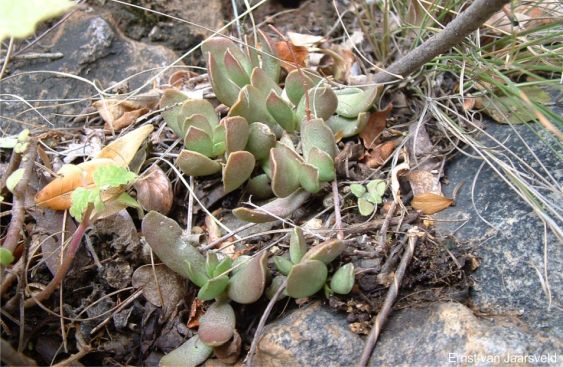
Fig. 1. A close-up of a cluster of Adromischus umbraticola subsp. ramosus growing on a sandstone ledge among grass.
Description
Description
Plants are dwarf-sized, compact, much-branched, up to 120 mm in diameter, with a tuberous base. The roots are fibrous. The branches are compact, forming dense clusters up to 120 mm long, grey to grey-green. The leaves are 15–65 × 5–21 mm, flattened (dorsiventrally compressed), compact, brittle, ascending, oblanceolate, green tinged with brown, rarely grey-green. The inflorescence is a spike-like thyrse, up to 350 mm high, bearing 1-flowered cymes 1.5–3.5 mm long. The pedicel 2–10 mm long. The buds erect, 5-angled, gradually tapering. The calyx lobes up to 3 mm long. The corolla 10–13 long, tubular; the tube 2 mm in diameter, dull green, grooved lengthwise; lobes triangular-ovate, up to 2.5 mm long, white or tinged pink, acute. The anthers are shortly exserted. Flowering is in early summer (November).
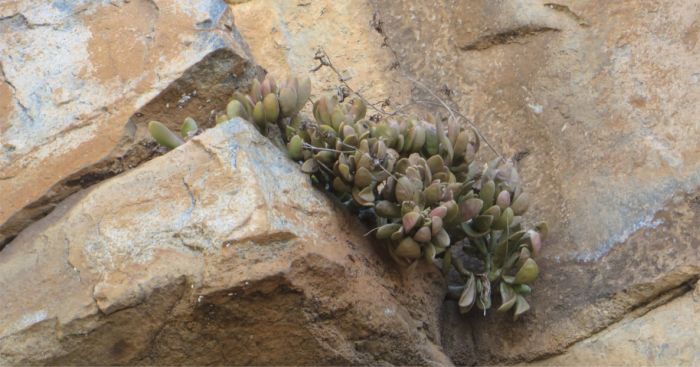
Fig. 2. A close-up of a cluster of Adromischus umbraticola subsp. ramosus in fruit, growing on a sandstone ledge.
Conservation Status
Status
Classified as Data Deficient – Taxonomically Problematic (DDT) by the Red List of South African Plants, its distribution range is not defined enough for the Red List to assess its risk of extinction, however it is not regarded as threatened because the plants are safeguarded by their difficult to reach habitat and its distribution falls within a greater conservation region.
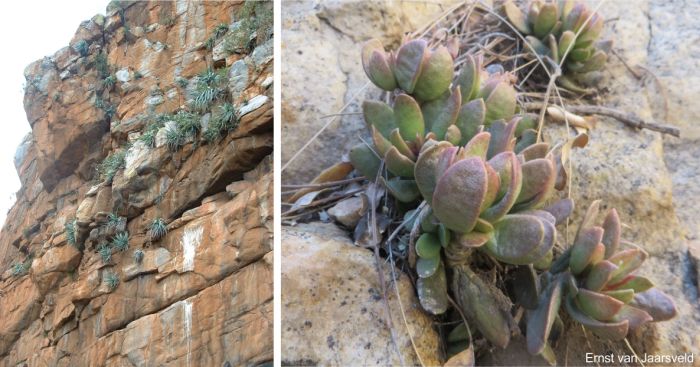
Fig. 3. The cliffs at Chuniespoort, near Polokwane in Limpopo Province, habitat of Adromischus umbraticola subsp. ramosus, and a close-up of a cluster on a sandstone ledge.
Distribution and habitat
Distribution description
Adromischus umbtaticola subsp. ramosus is known only from isolated collections near Middelburg in Mpumalanga, Chuniespoort, the Soutpansberg and the Blouberg in Limpopo, growing at altitudes between 600 and 1 500 m. They grow mainly cliffs (all aspects), sometimes in the shade. Plants are firmly rooted in crevices. Temperatures are high in summer, reaching 30°C and higher. The average daily maximum temperature is about 22–24°C and the average daily minimum 8–10°C. The rainfall occurs mainly in summer, ranging from 600–800 mm, in the form of thunder showers.
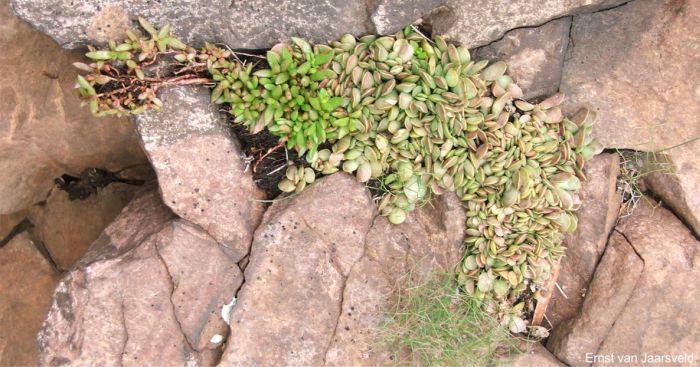
Fig. 4. A close-up of a dense cluster of the Adromischus umbraticola subsp. ramosus growing on a sandstone ledge with Crassula setulosa, Drimia intricata.
The associated vegetation consists of the Gold Reef Mountain Bushveld and Waterberg Mountain Bushveld of the Central Bushveld Bioregion, Savanna Biome. Associated cremnophytes on the sheer cliffs in the Blouberg (Limpopo Province) include: Aeollanthus buchnerianus (= A. canescens), Aloe arborescens, Aloe vogtsii, Cotyledon barbeyi, Crassula setulosa var. setulosa, Crassula swaziensis, Coleus mutabilis (= Plectranthus mutabilis) and Cynanchum viminale (= Sarcostemma viminale). The geology consists of quartzitic sandstone (Setlaole Formation, Waterberg Group and Wyllies Poort Formation, Soutpansberg Group).
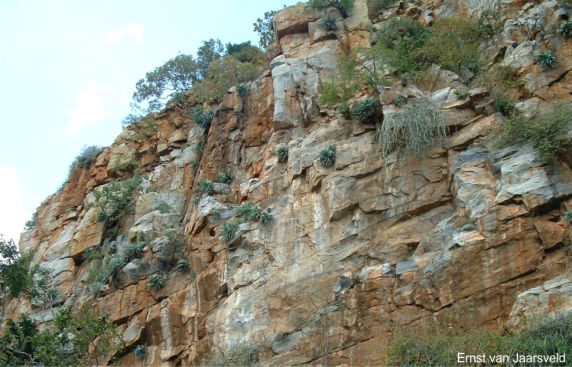
Fig. 5. The cliffs at Chuniespoort, habitat of Adromischus umbraticola subsp. ramosus, where plants grow on sandstone ledges among Aloe mutabilis, Cynanchum viminale and Crassula setulosa.
Derivation of name and historical aspects
History
Adromischus umbraticola subsp. ramosus was named by Helmut Toelken, former South African botanist and crassulacean specialist, in the Bothalia botanical magazine in 1978. He collected the plant at Chuniespoort in the Limpopo Province. The subspecies name ramosus pertains to its much branching habit, from the Latin ramosus meaning branching. Adromischus umbraticola subsp. umbraticola was named by Christo Albertyn Smith in the Onderstepoort Journal of Veterinary Science in 1933 from plants he collected at Silkaatsnek. The species name means shade dwelling, from the Latin umbra, meaning shade, and cola, dwelling. It also grows on cliffs and steep slopes in the Gauteng region. The subspecies ramosus differs from the typical subspecies umbraticola, according to Toelken, by its green leaves. Adromischus umbraticolus subsp. umbraticola has grey-green or glaucous leaves.
Adromischus umbraticola is one of three Adromischus species that belong in section Boreali, established by Toelken in the Bothalia botanical magazine in 1978. The name Boreali is Latin and appropriately means north, because the three species, A. trigynus, A. umbraticola and A. schuldtianus have the northernmost distribution. Of these A. schuldtianus subsp. brandbergensis occurs on the Brandberg in northern Namibia, the furthest north recorded for any known species of Adromischus. The section Boreali can be recognized by its slightly grooved, cylindrical corolla tube, the lobes egg-shaped to egg-shaped triangular, and usually reflexed against the tube, and with protruding anthers.
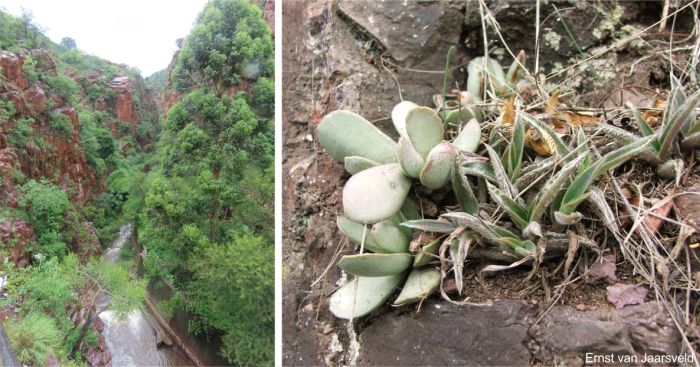
Fig. 6. Wyliespoort, Soutpansberg, Limpopo Province, the northern-most distribution of Adromischus umbraticola and a close-up of Adromischus umbraticola subsp. ramosus sharing its habitat with Cyanotis speciosa on a sandstone ledge among grass.
Ecology
Ecology
Plants form dense clusters. Branches and leaves root where they touch ground. The plants are conspicuous on the cliff face, often filling an entire crevice. The succulent nature of the leaves and stems allows survival during the dry winter months and also periods of drought at other times of the year. The stems are grey to grey-green, 60-120 mm long. The stems are much longer than in related species, suggesting an adaptation in becoming pendent from the cliff face. The stems are brittle and easily become detached and root easily if they fall on suitable substrate, suggesting a vegetative reproductive strategy so as to fully occupy the crevice. The leaf colour is uniform dull green, not mottled, and tinged brownish and functional for more than a year. The leaves are soft and unarmed, and adaptation to the undisturbed cliff face.
The flowers are tubular, with pink lobes, pollinated by insects. Flowering is in early summer (November). The fruiting capsules are dehiscent, and the seeds spontaneously released and dispersed by wind during summer and autumn, in time for the spring rains and thus for establishment. The seed is minute and ideal for establishment in crevices.
Like most other species of Adromischus, this plant proliferates from detached stems and leaves (caused by heavy wind or other disturbances), a vegetative reproductive backup system ensuring long-term survival.
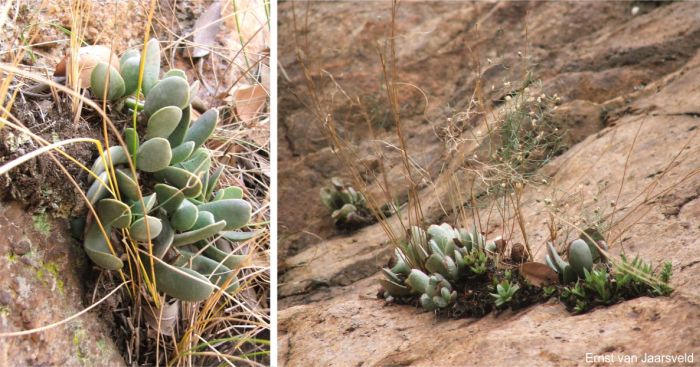
Fig. 7. Close-ups of Adromischus umbraticola subsp. ramosus on a sandstone ledge sharing its habitat with Crassula setulosa, Drimia intricata and grass.
Growing Adromischus umbraticola subsp. ramosus
Grow
Adromischus umbraticola subsp. ramosus is usually easily grown, the plants rapidly dividing, forming dense clusters, and are becoming popular as a pot plants in cultivation. It grows best in dappled shade in a sandy-loam to loamy soil. Plants respond rapidly to watering, becoming turgid and filling the containers. Plants can be fed with an organic fertiliser throughout the year. Its very easy growing nature maximises its survival rate. Plants adapt well to containers. In regions outside of its habitat they do best in ceramic containers. They also grow well with other succulents in miniature succulent gardens where conditions can be controlled. Grow in a gravely or sandy soil which drains well. Keep in dappled shade. Avoid over watering as plants tend to rot. Water should be provided throughout the year, but sparingly.
Plants are easily propagated by division or stem cuttings taken in late summer. According to Pilbeam et al. (1998), unlike most other Adromischus which are easily grown from leaf cuttings, this species is difficult to root from leaves.
Sow seed in winter or spring in a shallow tray in a sandy mixture and keep moist. Germination is within 3 weeks and once large enough to handle, transfer to individual containers. Place container in a shady position but with full light. The south side of a building is ideal.
Plants are relatively disease free except for root rot caused by too much watering, and aphids, wine weevils, slugs and snails can sometimes be a problem.
References
- Johnson, M.R., Anhaeusser, C.R. & Thomas, R.J. (eds). The geology of South Africa. Geological Society of South Africa, Johannesburg/Council for Geoscience, Pretoria.
- Mucina, L. & Rutherford, M.C. (eds) 2006. The vegetation of South Africa, Lesotho and Swaziland. Strelitzia 19. South African National Biodiversity Institute, Pretoria.
- Pilbeam, J., Rodgerson, C. & Tribble, D. 1998. Adromischus. The Cactus File Handbook 3. Cirio Publishing Services, Southampton.
- Raimondo, D. 2021. Adromischus umbraticola C.A.Sm. subsp. ramosus Toelken. National Assessment: Red List of South African Plants version 2024.1. https://redlist.sanbi.org/species.php?species=3831-52. Accessed on 2025/10/18.
- Rodgerson, C. & Cocozza, J. 1994. Adromischus. British Cactus & Succulent Society. Vol. 12: No.2
- Toelken, H.R. 1978. New taxa and combinations in Cotyledon and allied genera. Bothalia 12(3): 377–393.
- Toelken, H.R. 1985. Crassulaceae. Flora of Southern Africa 14: 1–244.
- Van Jaarsveld, E.J. 2003. New cliff-dwelling Crassulaceae from the Eastern Cape: a new Cotyledon and two new Adromischus taxa from the Mbashe and Mzimvubu Rivers, South Africa. Aloe 40: 2: 36–39.
- Van Jaarsveld, E.J. 2010. Waterwise gardening in South Africa and Namibia. Struik, Cape Town.
- Van Jaarsvekd, E.J., Nordenstam, B. & Van Wyk, A.E. 2004. Adromischus schuldtianus subsp. brandbergensis, a new subspecies and a checklist of the succulent flora of the Brandberg, Namibia. Bothalia 34: 35–38.
- Von Poellnitz, K. 1940. Zur Kenntnis der Gattungen Cotyledon L. und Adromischus Lem. Feddes repertorium specierum novarum regni vegetabilis, Zeitschrift für systematische Botanik 48: 80–113.
Credits
Ernst van Jaarsveld
Kirstenbosch National Botanical Garden (Retired)
Babylonstoren Farm (Current)
Extraordinary senior lecturer and researcher,
Department of Biodiversity and Conservation, University of the Western Cape
October 2025
Plant Attributes:
Plant Type: Succulent
SA Distribution: Limpopo, Mpumalanga
Soil type: Sandy
Flowering season: Early Summer
PH: Acid
Flower colour: White, Pink
Aspect: Shade, Morning Sun (Semi Shade)
Gardening skill: Easy
Special Features:
Horticultural zones
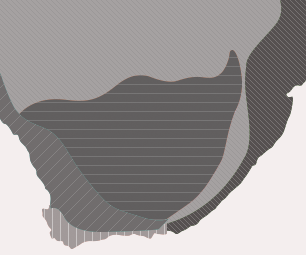






Rate this article
Article well written and informative
Rate this plant
Is this an interesting plant?
Login to add your Comment
Back to topNot registered yet? Click here to register.